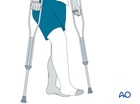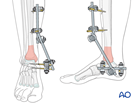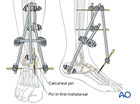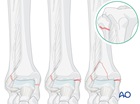Long-leg circular cast
Main indications
General considerations
Nonoperative treatment of ankle fractures is usually reserved for inherently stable fractures, but can be indicated for unstable fractures in the presence of local, or general, contraindications to surgery.
Indications
- Marked soft-tissue swelling
- Medical compromise
- Vascular disease
- Nonambulant patient
- Undisplaced fractures
- Patient not fit for surgery
- Peripheral vascular diseases
- Poor state of soft tissues
Contraindications
- Dislocated or unstable joint
- Inadequate reduction and unstable syndesmosis
- Shortening of the fibula
- Joint subluxation
- Significant articular posterior fragment
- Open fractures with severe soft-tissue injury
Advantages
- Full weight bearing possible
- Relatively good stability
Disadvantages
- Risks of cast complications (eg, pressure ulcer, nerve compression)
- Risks of immobilization
- Risk of secondary displacement and post-traumatic arthrosis
- Risk of malunion
- Possible longer period of rehabilitation
General considerations
Nonoperative treatment of ankle fractures is usually reserved for inherently stable fractures, but can be indicated for unstable fractures in the presence of local, or general, contraindications to surgery.
Indications
- Marked soft-tissue swelling
- Medical compromise
- Vascular disease
- Nonambulant patient
- Undisplaced fractures
- Patient not fit for surgery
- Peripheral vascular diseases
- Poor state of soft tissues
Contraindications
- Dislocated or unstable joint
- Inadequate reduction and unstable syndesmosis
- Shortening of the fibula
- Joint subluxation
- Significant articular posterior fragment
- Open fractures with severe soft-tissue injury
Advantages
- Full weight bearing possible
- Relatively good stability
Disadvantages
- Risks of cast complications (eg, pressure ulcer, nerve compression)
- Risks of immobilization
- Risk of secondary displacement and post-traumatic arthrosis
- Risk of malunion
- Possible longer period of rehabilitation

















